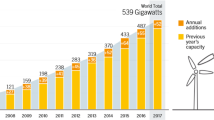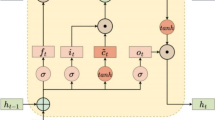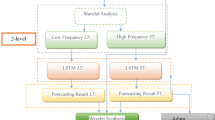Abstract
The randomness and instability of wind power bring challenges to power grid dispatching. Accurate prediction of wind power is significant to ensure the stable development of power grid. In this paper, a new ultra-short-term wind power forecasting model based on complete ensemble empirical mode decomposition with adaptive noise (CEEMDAN) and long-short-term memory (LSTM) network optimized by improved whale optimization algorithm (IWOA) is proposed. Firstly, CEEMDAN is applied to decompose the power history data into several intrinsic mode functions (IMFs) and a residual (RS) to reduce the complexity and unsteadiness of the original data. Then the partial autocorrelation method is used to analyze and select the input variables of each IMF and the residual. Finally, the IWOA-LSTM prediction model is established, and the parameters of LSTM are optimized by using the improved whale optimization algorithm. Each IMF and the residual are predicted respectively. The prediction results are superimposed to obtain the final wind power prediction value. The hybrid model is applied to the ultra-short-term wind power prediction of a wind farm in northern China. The prediction results of comparison experiments with other 11 models prove the effectiveness of the proposed model.














Similar content being viewed by others
Data availability
The datasets used or analyzed during the current study are available from the corresponding author on reasonable request.
References
An XL, Jiang DX, Zhao MH, Liu C (2012) Short-term prediction of wind power using EMD and chaotic theory. Commun Nonlinear Sci Numer Simul 17:1036–1042
Bhaskar K, Singh SN (2012) AWNN-assisted wind power forecasting using feed-forward neural network. IEEE Trans Sustain Energy 3:306–315
Cao J, Li Z, Li J (2019) Financial time series forecasting model based on CEEMDAN and LSTM. Physica A 519:127–139
Ding M, Zhou H, Xie H, Wu M, Liu KZ, Nakanishi Y, Yokoyama R (2021) A time series model based on hybrid-kernel least-squares support vector machine for short-term wind power forecasting. ISA Trans 108:58–68
Dragomiretskiy K, Zosso D (2014) Variational mode decomposition. IEEE Trans Signal Process 62:531–544
El-Fouly THM, El-Saadany EF, Salama MMA (2007) Improved Grey predictor rolling models for wind power prediction. IET Gener Transm Distrib 1:928–937
Erdem E, Shi J (2011) ARMA based approaches for forecasting the tuple of wind speed and direction. Appl Energy 88:1405–1414
Foley AM, Leahy PG, Marvuglia A, McKeogh EJ (2012) Current methods and advances in forecasting of wind power generation. Renew Energy 37:1–8
Han L, Jing HT, Zhang RC, Gao ZY (2019) Wind power forecast based on improved long short term memory network. Energy 189:9
Hochreiter S, Schmidhuber J (1997) Long short-term memory. Neural Comput 9:1735–1780
Jung J, Broadwater RP (2014) Current status and future advances for wind speed and power forecasting. Renew Sust Energ Rev 31:762–777
Li G, Shi J (2010) On comparing three artificial neural networks for wind speed forecasting. Appl Energy 87:2313–2320
Liu D, Niu DX, Wang H, Fan LL (2014) Short-term wind speed forecasting using wavelet transform and support vector machines optimized by genetic algorithm. Renew Energy 62:592–597
Liu X, Zhou J, Qian HM (2021) Short-term wind power forecasting by stacked recurrent neural networks with parametric sine activation function. Electr Power Syst Res 192:18
Ma XL, Tao ZM, Wang YH, Yu HY, Wang YP (2015) Long short-term memory neural network for traffic speed prediction using remote microwave sensor data. Transp Res Pt C-Emerg Technol 54:187–197
Mirjalili S, Lewis A (2016) The whale optimization algorithm. Adv Eng Softw 95:51–67
Mughal MO, Lynch M, Yu F, McGann B, Jeanneret F, Sutton J (2017) Wind modelling, validation and sensitivity study using Weather Research and Forecasting model in complex terrain. Environ Modell Softw 90:107–125
Ren C, An N, Wang JZ, Li L, Hu B, Shang D (2014) Optimal parameters selection for BP neural network based on particle swarm optimization: a case study of wind speed forecasting. Knowledge-Based Syst 56:226–239
Santamaria-Bonfil G, Reyes-Ballesteros A, Gershenson C (2016) Wind speed forecasting for wind farms: a method based on support vector regression. Renew Energy 85:790–809
Santhosh M, Venkaiah C, Kumar DMV (2018) Ensemble empirical mode decomposition based adaptive wavelet neural network method for wind speed prediction. Energy Convers Manage 168:482–493
Shahid F, Zameer A, Muneeb M (2021) A novel genetic LSTM model for wind power forecast. Energy 223:11
Srivastava N, Mansimov E, Salakhutdinov R (2015): Unsupervised learning of video representations using LSTMs, 32nd International Conference on Machine Learning. Proceedings of Machine Learning Research. Jmlr-Journal Machine Learning Research, Lille, FRANCE, pp. 843–852
Sun W, Wang Y (2018) Short-term wind speed forecasting based on fast ensemble empirical mode decomposition, phase space reconstruction, sample entropy and improved back-propagation neural network. Energy Convers Manage 157:1–12
Tian ZD (2020) Short-term wind speed prediction based on LMD and improved FA optimized combined kernel function LSSVM. Eng Appl Artif Intell 91:24
Wang YY, Wang JZ, Zhao G, Dong Y (2012) Application of residual modification approach in seasonal ARIMA for electricity demand forecasting: a case study of China. Energy Policy 48:284–294
Wang SX, Zhang N, Wu L, Wang YM (2016) Wind speed forecasting based on the hybrid ensemble empirical mode decomposition and GA-BP neural network method. Renew Energy 94:629–636
Wang Y, Hu QH, Meng DY, Zhu PF (2017) Deterministic and probabilistic wind power forecasting using a variational Bayesian-based adaptive robust multi-kernel regression model. Appl Energy 208:1097–1112
Wang H, Han S, Liu YQ, Yan J, Li L (2019a) Sequence transfer correction algorithm for numerical weather prediction wind speed and its application in a wind power forecasting system. Appl Energy 237:1–10
Wang Y, Hu QH, Srinivasan D, Wang Z (2019b) Wind power curve modeling and wind power forecasting with inconsistent data. IEEE Trans Sustain Energy 10:16–25
Yang S, Chen D, Li S, Wang W (2020) Carbon price forecasting based on modified ensemble empirical mode decomposition and long short-term memory optimized by improved whale optimization algorithm. Sci Total Environ 716:137117
Yu RG, Gao J, Yu M, Lu WH, Xu TY, Zhao MK, Zhang J, Zhang RX, Zhang Z (2019) LSTM-EFG for wind power forecasting based on sequential correlation features. Futur Gener Comp Syst 93:33–42
Zhang WY, Qu ZX, Zhang KQ, Mao WQ, Ma YN, Fan X (2017) A combined model based on CEEMDAN and modified flower pollination algorithm for wind speed forecasting. Energy Conversion Manage 136:439–451
Zhao J, Guo Y, Xiao X, Wang J, Chi D, Guo Z (2017) Multi-step wind speed and power forecasts based on a WRF simulation and an optimized association method. Appl Energy 197:183–202
Zhao Z, Nan H, Liu Z, Yu Y (2022): Multi-step interval prediction of ultra-short-term wind power based on CEEMDAN-FIG and CNN-BiLSTM. Environ Sci Pollut Res Int
Author information
Authors and Affiliations
Contributions
Shaomei Yang: conceptualization, methodology, supervision. Aijia Yuan: data curation, writing—original draft preparation, writing—reviewing and editing. Zhengqin Yu: software, performing the experiments.
Corresponding author
Ethics declarations
Ethics approval and consent to participate
Not applicable.
Consent for publication
Not applicable.
Competing interests
The authors declare no competing interests.
Additional information
Responsible Editor: Philippe Garrigues
Publisher's note
Springer Nature remains neutral with regard to jurisdictional claims in published maps and institutional affiliations.
Appendix
Appendix
Tables 7, 8, 9, 10, 11, 12, 13, 14, 15, 16, 17, and 18.
Rights and permissions
Springer Nature or its licensor holds exclusive rights to this article under a publishing agreement with the author(s) or other rightsholder(s); author self-archiving of the accepted manuscript version of this article is solely governed by the terms of such publishing agreement and applicable law.
About this article
Cite this article
Yang, S., Yuan, A. & Yu, Z. A novel model based on CEEMDAN, IWOA, and LSTM for ultra-short-term wind power forecasting. Environ Sci Pollut Res 30, 11689–11705 (2023). https://doi.org/10.1007/s11356-022-22959-0
Received:
Accepted:
Published:
Issue Date:
DOI: https://doi.org/10.1007/s11356-022-22959-0




